Cat lovers around the globe are captivated by the sheer variety of colors and patterns that adorn our feline companions. Each cat boasts a unique coat, making them truly special. This breathtaking diversity, however, stems from a surprisingly simple genetic foundation. In fact, at their core, all cats are fundamentally either black or orange!
The genetic mechanisms governing a cat’s coat color operate much like a sophisticated photo-editing tool. A few key genes act as filters and modifiers, working on a “base layer” to ultimately produce the stunning array of feline fur colors we admire.
Let’s delve into the fascinating world of feline genetics to unravel the mystery of how your beloved kitty acquired their gorgeous coat.
The Black or Orange Foundation
It might sound unbelievable, but it’s a genetic truth: there are only TWO primary colors in the feline coat color palette. Every cat, deep down, is either black, orange, or a combination of both.
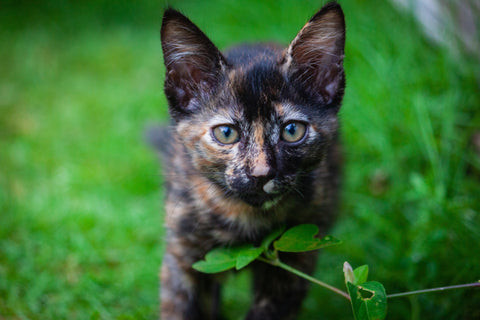 A close up of a black and white cat face
A close up of a black and white cat face
The majority of cats express just one of these base colors. The exception is the tortoiseshell cat, displaying a beautiful patchwork of orange and black. This unique color pattern is due to the color gene being located on the X chromosome. Since female cats possess two X chromosomes, they can inherit one X chromosome carrying the orange gene and another carrying the black gene. This results in the distinctive tortoiseshell pattern.
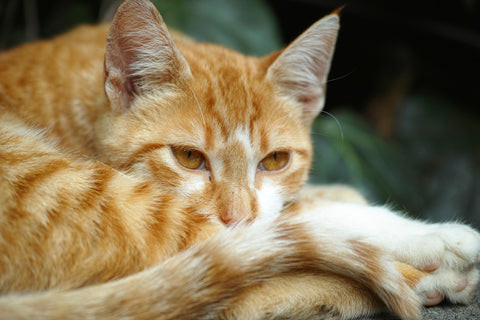 A tortoiseshell cat sitting on a wooden surface
A tortoiseshell cat sitting on a wooden surface
Male cats, with only one X chromosome (XY), can only be either black or orange – not both. Consequently, almost all tortoiseshell cats are female. Rare genetic anomalies can lead to a male tortoiseshell, but these are exceptions to the rule.
Interestingly, orange cats are more frequently male. Approximately 80% of orange cats are male. This is because a male cat only needs to inherit a single orange X chromosome to develop a ginger coat. In contrast, a female cat needs to inherit the orange gene on both of her X chromosomes to be orange.
As the orange gene is less prevalent than the black gene, it’s statistically less likely for a female cat to inherit two orange X chromosomes. For a female to be orange, she would either need two orange parents (guaranteeing orange offspring) or an orange father and a tortoiseshell mother. In the latter scenario, she would have a 50% chance of being orange like her father and a 50% chance of being tortoiseshell like her mother.
In essence, due to the statistical rarity of orange females, most orange cats you encounter will be male!
Solid Cat Fur Colors: Shades of Black
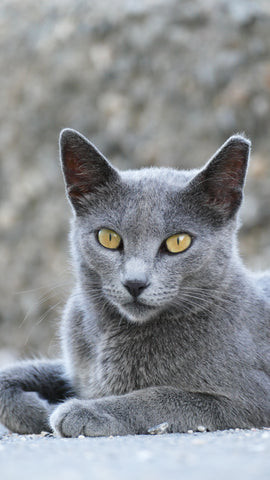 A grey cat with yellow eyes looking directly at the camera
A grey cat with yellow eyes looking directly at the camera
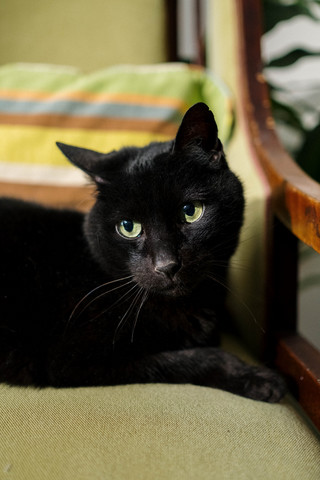 A close up of a sleek black cat's face
A close up of a sleek black cat's face
You might be thinking, “But I’ve seen cats in many more colors than just black and orange!” If all cats start with a black or orange base, where do these other colors originate?
These diverse colors arise from “modifier” genes that act as filters on the baseline colors. Imagine it as an Instagram filter applied to the initial black or orange “image.”
All solid-colored cats, excluding white, are fundamentally black. However, they may carry genes that dilute this black pigment into a variety of other shades. These dilution genes can transform black into colors like brown, blue (gray), lilac, fawn, or cinnamon.
For example, the elegant Russian Blue cat is genetically a solid black cat. However, it possesses a dilution gene that lightens the black pigment to a beautiful gray. Havana Browns are also genetically black cats, but a different dilution gene transforms their black coat into a rich chocolate brown. On the other hand, all-black cats proudly display their natural, undiluted color – the #nofilter of the cat fur color world!
So, any cat that exhibits a single, uniform color (again, except white) is genetically black, and this black may or may not be modified by dilution genes. We will explore solid white cats a bit later.
The Tabby Exception for Solid Orange
Similar to how black can be diluted to gray, the orange base color can be diluted to cream. However, unlike black cats, a truly solid orange or cream cat is a rarity. This is because the tabby gene interacts uniquely with orange pigment, meaning solid orange cats are virtually nonexistent.
While Thomas O’Malley from Disney’s Aristocats is a charming character, a genuinely solid orange cat like him is highly improbable in reality. Barring extremely rare genetic mutations, a cat’s coat cannot be a completely solid orange. Orange cats will always exhibit a tabby pattern.
Tabby Cat: Patterned by Nature
Now we understand that all cats are fundamentally black or orange, and their pigment intensity can be modified through dilution.
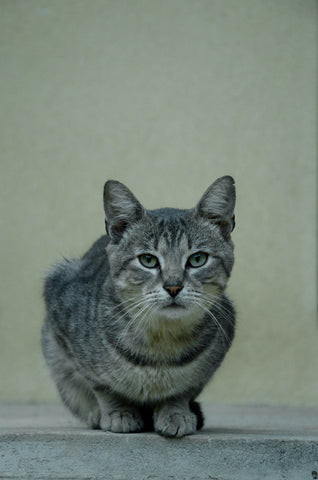 A tabby cat looking out of a window
A tabby cat looking out of a window
Beyond base color and dilution, every cat also falls into one of two pattern categories: Tabby or Non-Tabby.
All cats carry either the “agouti” gene (tabby pattern) or the “non-agouti” gene (no tabby pattern). The agouti gene is dominant and more common, explaining why tabby patterns are so prevalent in cats. In fact, it could be argued that all cats are genetically predisposed to be tabby, but in cats with the non-agouti gene, the tabby pattern is effectively “switched off.”
Even with just these genetic variations – black vs. orange base, color dilution, and tabby vs. non-tabby – a remarkable number of coat color combinations are possible.
Consider a cat with a black baseline color that is diluted to gray, and also possesses the agouti gene. This genetic combination results in a gray tabby cat!
Did you know that black cats can also be tabby? It’s true! Black cats can carry the agouti gene, but the tabby markings are often subtle and difficult to see. You might catch a glimpse of the tabby pattern in black kittens or when the sunlight catches their fur just right.
In popular culture, many famous feline characters, such as Garfield or Puss-in-Boots, are iconic orange tabbies.
Intriguingly, even if an orange cat inherits the non-agouti gene, their underlying tabby pattern doesn’t disappear. This is because the non-agouti gene only affects black pigment. It has no impact on orange pigment.
This genetic quirk leads to a fascinating conclusion: all orange cats are inherently tabby!
Tabby Patterns: Spots and Stripes
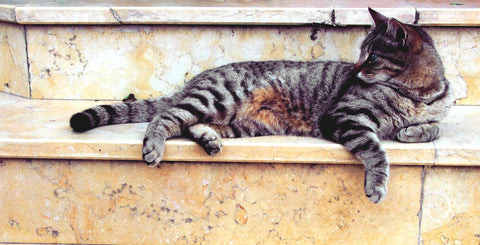 A spotted tabby cat with green eyes looking directly at the camera
A spotted tabby cat with green eyes looking directly at the camera
Just as the base orange or black color can be diluted to create a spectrum of shades, the agouti gene itself can be further modified to produce four distinct types of tabby patterns.
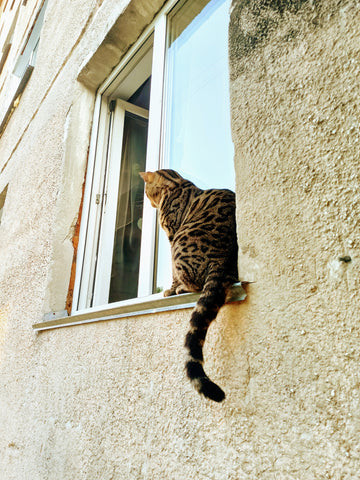 A mackerel tabby cat with stripes
A mackerel tabby cat with stripes
The most common tabby pattern, and the one that often comes to mind first, is the “mackerel” tabby. This pattern features vertical stripes resembling the stripes on a mackerel fish, giving it a “tiger-striped” appearance.
The second most common tabby pattern is the “classic” or “marbled” tabby. This pattern is characterized by bold, swirling patterns and blotches across the coat.
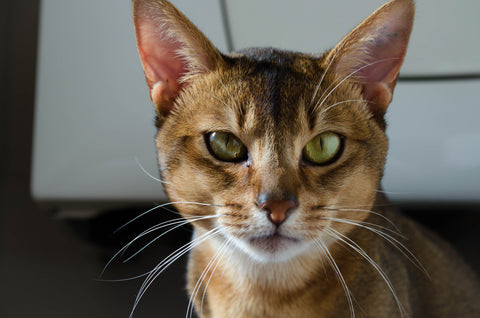 A classic tabby cat with a marbled pattern
A classic tabby cat with a marbled pattern
The “spotted” tabby pattern is often perceived as the most wild or exotic due to its resemblance to large wild cats like jaguars and leopards. Spotted tabby patterns are frequently seen in breeds like the Bengal or Savannah cat, which are domestic breeds intentionally crossed with non-domesticated cat species, such as servals.
Finally, the “ticked” tabby pattern is the most unusual and often doesn’t even appear tabby at first glance. This pattern results in subtle stripes primarily on the cat’s head and legs, while the body fur has a speckled appearance due to bands of color on each hair shaft. The Abyssinian cat breed is a classic example of a ticked tabby.
Bicolor and Tricolor Cat Fur: The White Factor
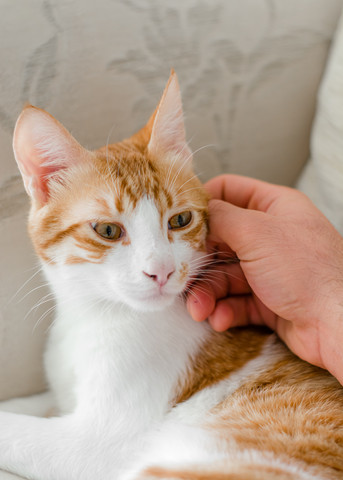 An orange and white bicolor cat sitting and looking to the side
An orange and white bicolor cat sitting and looking to the side
We’ve explored orange vs. black, tabby vs. non-tabby, and color dilutions. Now, there’s one more significant gene that introduces patches of white into many cat coats.
This is the “masking” gene, also known as the white spotting gene. It essentially masks or covers any underlying color with white, regardless of the cat’s base color. If the masking gene is only expressed in certain areas of the cat’s body, it’s called partial masking or “piebald.” If the masking gene is expressed throughout the entire body, it’s complete masking, resulting in an all-white cat!
Piebald Patterns: Bicolor and Tricolor Variations
A bicolor cat exhibits a coat that is part white and part another color. The colored portions can be orange or black, diluted or undiluted, and tabby or non-tabby.
There is a wide array of beautiful bicolor patterns. A very common one is a predominantly black cat with a white chest patch, often referred to as a tuxedo cat. It’s also common for cats to have just a small white spot on their chest, known as a locket pattern.
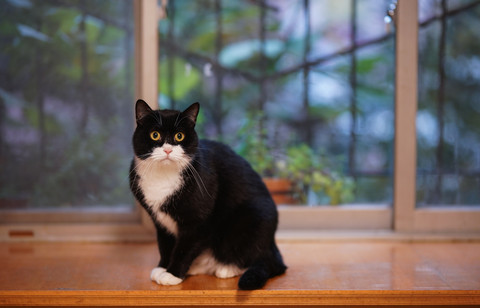 A black and white tuxedo cat sitting upright
A black and white tuxedo cat sitting upright
As the name suggests, a tricolor cat displays three distinct colors: white, orange, and black. Similar to bicolor cats, the colored sections can also be diluted or tabby patterned.
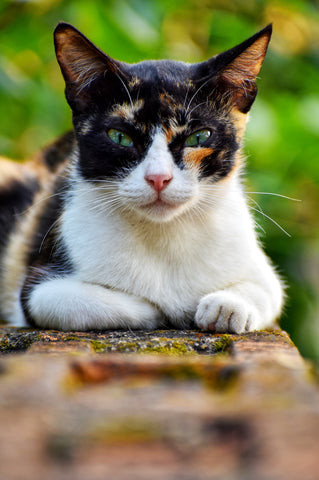 A calico cat with orange, black, and white fur lying down
A calico cat with orange, black, and white fur lying down
As we previously learned, only female cats can naturally be both orange and black. Therefore, all tricolor cats are female! Tricolor cats are more commonly known as calico cats.
It’s easy to confuse the terms tortoiseshell and calico. A tortoiseshell cat is any cat that has both orange and black coloration, while a calico cat must have orange, black, and white. This means all calico cats are technically tortoiseshells, but not all tortoiseshells are calico!
Snowball Cats: Albinism vs. White Masking
A common misconception is that all white animals are albino. However, this is not typically the case. So, what distinguishes an all-white cat from a true albino cat?
A true albino cat has a genetic condition that prevents its body from producing any pigment at all – regardless of the color genes it possesses. An albino cat might genetically be programmed to be orange, black, or any pattern, but due to its cells’ inability to produce pigment (specifically melanin), these color genes are not expressed.
Think of it like a “paint-by-numbers” kit. Even if the instructions specify painting areas blue, red, or green, if you don’t have any paint, the final picture will be uncolored, no matter what the instructions indicate!
Cats with albinism may have increased health sensitivities, particularly to sunlight, but are otherwise normal cats and wonderful companions.
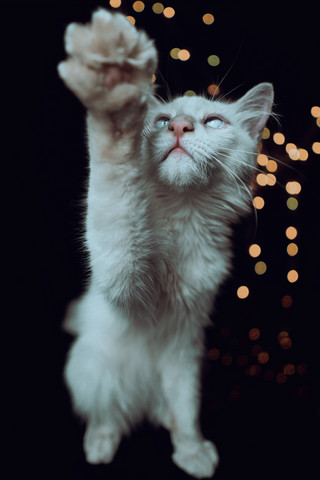 A white albino cat with pink eyes looking directly at the camera
A white albino cat with pink eyes looking directly at the camera
True albinism is extremely rare in cats. This means that most white cats are not albino. So, what makes them white? All-white cats possess the same masking gene that creates white patches in bicolor and tricolor cats, but in all-white cats, this gene is expressed across their entire body. This complete masking effect overrides any other fur color genes.
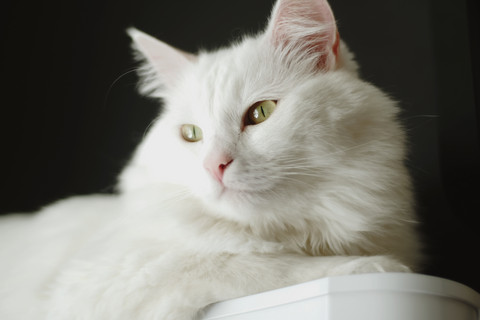 A fluffy white cat with blue eyes looking to the side
A fluffy white cat with blue eyes looking to the side
Returning to our paint-by-numbers analogy, imagine a pattern where the instructions specifically tell you to paint the entire picture white (perhaps a snow scene).
So, with albinism, a cat’s body cannot produce the color dictated by its genes, whereas an all-white cat is actually following its genetic instructions to be white.
How can you tell if your white cat is an albino or simply a masked white? There’s a simple way to differentiate! If a white cat has any color on its skin (like black spots on paw pads) or any color in its eyes (such as yellow or green), then it is not a true albino; it is a masked white cat. A true albino will have entirely pink skin and pink or pale blue eyes.
Pointed Patterns: Temperature-Sensitive Color
Beyond the masking gene, there’s another way cats can have white fur – and it involves a fascinating temperature-sensitive genetic mechanism!
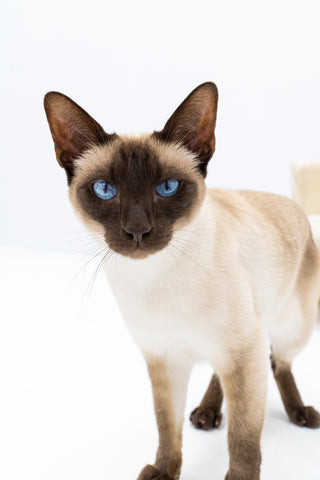 A Siamese cat with pointed pattern sitting on a couch
A Siamese cat with pointed pattern sitting on a couch
The “point” pattern describes cats with a lighter body color and darker extremities (face, legs, and tail). This pattern is most commonly seen in “Oriental” cat breeds like Siamese, Tonkinese, Burmese, Himalayan, and related breeds like Ragdolls or Snowshoes.
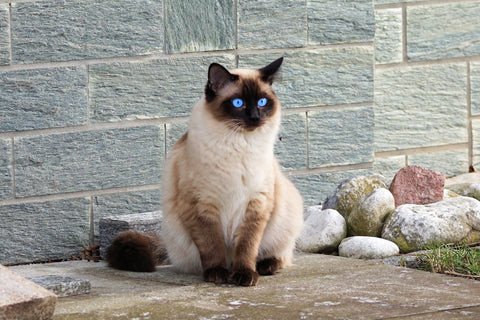 A seal point Siamese cat with blue eyes
A seal point Siamese cat with blue eyes
The white areas in a point pattern don’t arise from the usual masking gene. Instead, this pattern is actually a type of temperature-sensitive albinism!
In cats with the point pattern, the gene controlling pigment production is sensitive to temperature. Warmer areas of the cat’s body are unable to produce pigment. This explains why only the cooler extremities develop color: the face, ears, paws, and tail are the coolest parts of the body. This temperature sensitivity is also responsible for the characteristic blue eyes often seen in pointed cats.
Kittens with the point pattern are born almost entirely white and develop their colored points over a few weeks as they experience cooler temperatures outside the womb. This gene is so temperature-sensitive that if kittens with this gene are raised in a consistently warm environment during their first few weeks of life, they might not develop any points and essentially become all-white cats!
Cat Coat Color and Personality: Myth vs. Reality
Many anecdotes and stereotypes link a cat’s coat color to its personality. For example, orange cats are often perceived as lovable but dim-witted, while tortoiseshell cats are often characterized as having a feisty “tortitude.”
However, these stereotypes are likely human projections. For instance, since tortoiseshell cats are almost always female and orange cats are more often male, we might subconsciously expect females to be sassy and males to be less intelligent!
The scientific consensus is that cat coat color has not been reliably linked to personality. Cat breeds can influence personality traits – most people agree that Siamese cats are vocal and Maine Coons are generally laid-back – but coat color alone is not a predictor of whether your kitten will be playful or calm, curious or cautious, cuddly or independent. Remember, each cat is an individual with its own unique personality!
Cat coat colors are as diverse and unique as the personalities of our feline friends. The range of patterns and shades seems endless, yet it’s remarkable to realize that all this variety essentially boils down to just two base colors! A few genetic tweaks and “filters” are all it takes to create the breathtaking spectrum of feline beauty we admire.
The next time you are petting your purring cat, take a closer look at the intricate patterns in their fur – and appreciate the incredible genetic artistry that creates the amazing diversity of our favorite felines.
